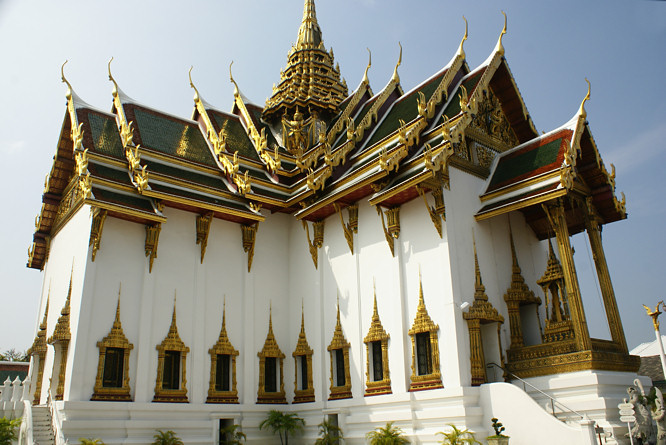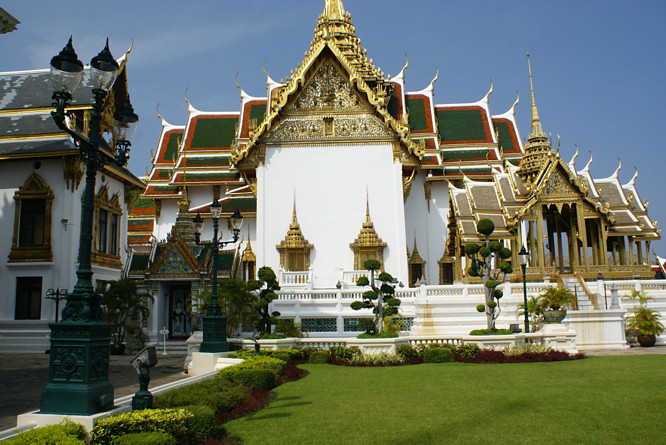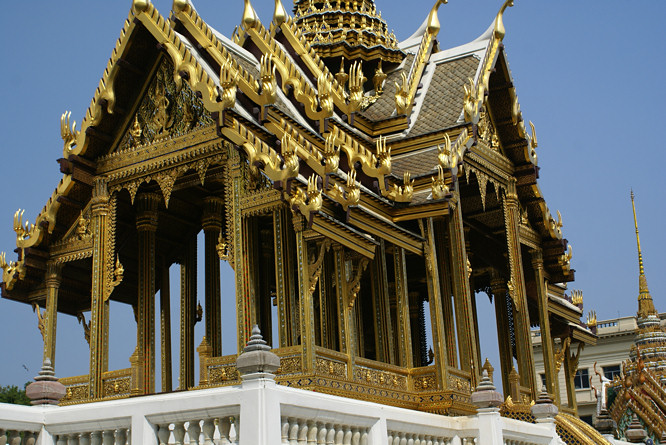Bangkok Dusit Maha Prasat Audience Hall and Aphornphimok Pavilion
The Dusit Maha Prasat was built as a Royal audience hall in 1789 by King Rama I. It is located next to the strange Thai State ceremonial Chakri Mahaprasad Hall which is an Italian renaissance influenced building with a roof that is in a traditional Thai architectural style.

The white walls and glazed roof tiles of red, gold and green with gold trim roof of the Dusit Maha Prasat complements the larger younger Chakri Mahaprasad Hall. The roof of the Dusit Maha Prasat culminates in a gilded mongkut, a spire shaped like the king's crown, which symbolizes the 33 Buddhist levels of perfection. Each tier of the roof bears a typical chofa, a slender, stylized bird's-head finial, and several hang hong (swans' tails), which represent three-headed nagas.
The building's large inner hall was intended to be the King's Audience Chamber. The beams and assorted furniture are contemporary to the first King's reign, while the murals were a later addition, as the building became the preferred venue for the lying-in-state of deceased kings. The north face has a porch with a type of throne known as a busabok used by the king when giving public audiences. The throne hall is open to the public on weekdays only.

Inside you can see a large mother-of-pearl inlaid throne, called the Phra Ratcha Banlang Pradap Muk, set just off the very center of the hall. To your left as you look at the throne is a large mother-of-pearl bed used for relaxing between audiences. The formal gardens and topiary trees that surround the Dusit Maha Prasat and Aphornphimok Pavilion are interesting and unusual.
On the west side of the throne hall is a small garden with a mound that is supposed to represents Mount Krailas. It is decorated with fabulous animals and topped by a castle and prang. The garden was once the site of the royal tonsure ceremony, when children had their heads shaved for the first time. Thai children had shaved heads, except for a tuft on the crown, which, between the age of five and eight, was cut in a Hindu initiation rite to welcome adolescence.
For the royal children, the rite was an elaborate ceremony that sometimes lasted five days, culminating with the king's cutting of the hair knot. The child was then bathed at the model Krailas, in water representing the original river of the universe flowing down the central mountain.

The Aphornphimok Pavilion
On the east wall of the Dusit Maha Prasat, King Rama IV had a beautiful small pavilion built as a changing area for when he arrived or departed by palanquin (note the shoulder height platform on the outside of the pavilion in the photo.) The delicate golden Aphornphimok Pavilion is considered the very height of Thai art. Rama V loved the building so much he had it copied at the palace at Bang Pa In. A replica was also displayed at the 1958 Worlds Fair in Brussels.
Travel books

